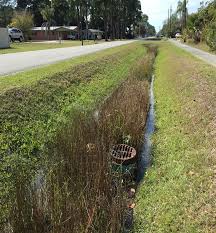Even though no major contruction projects are currently planned at the county’s 21.9-acre public works campus, officials are looking into options to see which are the best choices to minimize stormwater runoff and improve water quality entering adjacent Alligator Creek.
“The key challenges are the cost of construction and then the O&M (operation and management) costs – and they can be greater than anticipated if implementation is not properly planned, keeping the site constraints and existing conditions in mind,” notes Addie Javed, who recently took the reins as public works director after working on green projects in Sarasota County and Haines City. “Not every technology works in every application, we need to be realistic and look at soil and groundwater situations,” he added.

The stormwater initiative Javed directed for Sarasota County in Englewood in provides a view of what the improvements could look like in Pinellas, the most densely populated county in the state where nearly all new construction is redevelopment.
The Englewood Community Redevelopment Area (CRA) was the first low-impact design in southwest Florida and was created to spur commercial development in an area with small parcels and older buildings where it would not have been cost-effective to build individual stormwater treatment systems.
“We had a consortium of consultants from engineers and scientists to architects and inventors, and ended up with a project that includes bioswales, biofiltration, retention and pervious pavement that all had their own benefits,” Javed said.

The public works campus, located just off U.S. 19 in Clearwater, is not a typical destination for an average Pinellas County resident, but that may change as the county creates a showcase for stormwater technologies, adds Anamarie Rivera, senior environmental specialist.
“People don’t necessarily think of stormwater as an important consideration in ecosystem management but that’s changing,” she said. “They blame red tide and blue-green algae on big agriculture and septic tanks but stormwater runoff is a contributing factor to water pollution and there are technologies available to reduce those impacts.”
[su_divider top=”no” text=”Learn More:” style=”double” divider_color=”#5330f0″ margin=”25″]At a recent meeting, regional stormwater managers heard examples and case studies from several stormwater solutions including:

Bold & Gold, a biosorption activated media (BAM) patented by the University of Central Florida’s Stormwater Management Academy. Composed of both natural and recycled products, the media absorbs nitrogen, phosphorus, total suspended solids (TSS), and pathogens in runoff. In Florida, it is recognized by water management districts and the Department of Environmental Protection for nutrient reduction credits.

Permeable grass paving blocks from ACF Environmental. The Geoblock creates a permeable grass paving block two inches thick. In areas with low traffic, it can be left 95% open to catch stormwater, or backfilled for areas that need to handle heavier traffic.
Pavedrain was presented as an option to allowing stormwater infiltration from surfaces such as parking lots and sidewalks. The PaveDrain system is recognized by the US Environmental Protection Agency as a structural Best Management Practice for stormwater infiltration.
It is important for us at Bay Soundings to bring you information you may find interesting or useful. Reference in this article to any specific commercial product or organization name is for informational purposes and does not constitute endorsement, recommendation, or favoring by Bay Soundings or other governments mentioned.
Originally published March 23, 2019
[su_divider]